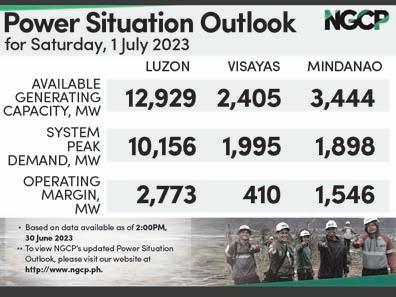
3 minute read
BSP expects June inflation to trend lower than, or mimic May’s 6.1%
By Cai U. Ordinario
In its month-ahead forecast, the BSP said inflation could settle within the range of 5.3 to 6.1 percent. Inflation was also at 6.1 percent in June 2022.

BSP said food and oil prices are still high, and the depreciation of the peso could cause prices to rise but other commodities such as meat and vegetables could keep inflation low or at the same rate last month. “Going forward, BSP will continue to monitor developments affecting the outlook for inflation and growth in line with its data-dependent approach to monetary policy formulation,” the BSP said in a statement issued on Friday.
Prices of key food items, such as rice, vegetables, and fish, along with the increase of domestic oil prices and electricity rates, as well as the depreciation of the peso are the primary sources of upward price pressures in June.
The lower prices of meat and fruits as well as the rollback in LPG prices could contribute to downward price pressures during the month.
The Philippine Statistics Authority (PSA) said the slowdown of inflation to 6.1 percent in May marked the fourth consecutive month of deceleration in headline inflation in the country.
Despite the decline, the inflation rate in May 2022 was still lower at 5.4 percent. The year-todate average inflation rate, that is from January to May 2023, stood at 7.5 percent.
The BSP earlier said it stands ready to resume its monetary policy tightening should the country’s domestic conditions warrant such a move.
This is despite the recent decision of the United States Federal Reserve to pause its monetary policy tightening stance. The Federal Open Market Committee (FOMC) earlier decided to maintain the target range for the federal funds rate at 5 to 5.25 percent.
I n the Philippine Economic Briefing (PEB) in Singapore aired live on social media, BSP Deputy Governor Francisco G. Dakila Jr. said the monetary policy actions of the Federal Reserve now carry less weight on the policy actions of the Monetary Board.
SHORTER-MATURITY
Philippine bonds look increasingly favorable relative to longer-dated ones, aided by the central bank’s pivot to an easing stance, which will also boost lending in the economy.
Emerging Asia’s formerly most hawkish central bank sent the two-to-10-year curve into inversion in May for the first time since June 2019. Yields have stayed around those levels since.
But Bangko Sentral ng Pilipinas’s (BSP) decision to cut the reserve requirement ratio—by 250 basis points versus an expected 200 basis points—should ease pressure on shorter yields, which will help the sovereign curve steepen.
“The reserve requirement ratio [RRR] cut increases demand for short-term government securities” as institutions would optimize returns on excess peso funds effectively infused into the financial system, said Michael Ricafort, chief economist at Rizal Commercial Banking Corp. in Manila.
The spread between twoand 10-year bonds dipped below zero in May, following a cumulative 425 basis points of rate hikes from the BSP since 2022. That was the largest tightening cycle among emerging Asia economies as the central bank sought to tame surging price pressures. But inflation is now slowing, with the consumer-price index dropping to 6.1 percent in May from a 15-year high of 8.7 percent in January. June inflation figures are due
Wednesday, and are expected to decelerate further to 5.5 percent, according to economist estimates.
Philippine authorities signaled the central bank would consider cutting rates in the first quarter of 2024, or if inflation comes in below 4 percent for two months. Rate cuts are expected to begin in that period, according to the median estimate of economists surveyed by Bloomberg. Some money managers though speculate easing may begin as early as the fourth quarter as gross domestic product may undershoot government estimates of above 6-percent growth.
Leading the way
Among the core Asia markets, the Philippines has “led the way in monetary easing, after having delivered the most aggressive tightening in the region,” HSBC strategists Pin Ru Tan and Himanshu Malik wrote in a note last week.
Shorter-maturity yields, which are more sensitive to rate expectations, may move in advance of the actual rate cut if history is a guide. Peso two-year yields started declining around five months ahead of eventual rate cuts in May 2016 and May 2019, as shorter yields fell by around 100 basis points on both occasions before the rate cut. Declining two-year yields would support a steepening in the sovereign yield curve.
“We expect the bond curve to steepen” as the RRR cut adds net liquidity into the system, the HSBC strategists said. Bloomberg News








